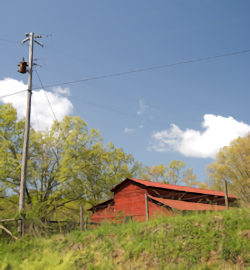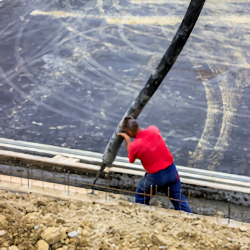Contact with Power Lines
Major Hazards
Overhead and buried power lines are especially hazardous because they carry extremely high voltage.
Fatalities are possible as electrocution is the main risk; however, burns and falls from elevations are also hazards that workers are exposed to while working in the vicinity of high voltage power lines. Workers may not realize that cranes are not the only equipment that reaches overhead power lines. Working on a ladder or in a man-basket suspended under or near power lines also poses a risk of electrocution.
This could save your life: The covering on an overhead power line is primarily for weather protection; therefore, workers need to know if they touch a power line, covered or bare, death is likely.
Voltages of overhead lines range from 120 to 750,000 volts. The most reliable way to know the voltage is to ask the utility company that owns the line.
Description of Accident
Two employees were installing aluminum siding on a farmhouse when it became necessary to remove a 36-foot high metal pole CB antenna.
One employee stood on a metal pick board between two ladders and unfastened the antenna at the top of the house. The other employee, who was standing on the ground, took the antenna to lay it down in the yard. The antenna made electrical contact with a 7200-volt power transmission line 30 feet 10 inches from the house and 23 feet 9 inches above the ground. The employee handling the antenna received a fatal shock and the other employee a minor shock.
Inspection Results
Following its investigation, OSHA issued one citation for two alleged serious violations of its construction standards. Had these standards been adhered to, the fatality might have been prevented.
What would you recommend?
Recommendations
- Note the presence of power lines and be extremely cautious when working near them. Train employees to recognize and avoid electrical hazards (1926.21(b)(2)).
- Do not permit employees to work near any part of an electrical power circuit that might be contacted in the course of the work. Guard all electrical power circuits against accidental contact by insulating the circuit or de-energizing it or by other effective means that would protect the employee (1926.400(C)(1)).
Description of Accident
A lineman was electrocuted while working on grounded de-energized lines.
He was working from a defective basket on an articulated boom aerial lift when the basket contacted energized lines that ran beneath the de-energized lines. The defective basket permitted current to pass through a drain hole cut into the body of the basket, and then through the employee, and to ground via the de-energized line.
Inspection Results
OSHA cited the company for two serious violations and one other-than-serious violation of its construction standards. Had barriers been erected to prevent contact with adjacent energized lines, the electrical shock might have been prevented.
What would you recommend?
Recommendations
- Guards or barriers must be erected as necessary to adjacent energized lines (29 CFR 1926.950(d)(1)(v)).
- Existing conditions of mechanical equipment, energized lines, equipment, conditions of poles, and an inspection or test will determine the location of the circuit before starting work. (29 CFR 1926.950(b)(1) and .952(a)(1)).
- Employees must be instructed on how to recognize and avoid unsafe conditions and on regulations that apply to their work environment (29 CFR 1926.21(b)(2)).
Description of Accident
Two employees were spreading concrete as it was being delivered by a concrete pumper truck boom. The truck was parked across the street from the worksite.
Overhead power lines ran perpendicular to the boom on the pumper truck. One employee was moving the hose (elephant trunk) to pour the concrete when the boom of the pumper truck came in contact with the overhead rover line carrying 7,620 volts. The employee received a fatal electric shock and fell on the other employee who was assisting him. The second employee received a massive electrical shock and burns. Safety training requirement was not being carried out at the time of the accident.
Inspection Results
OSHA cited the employer for not instructing each employee to recognize and avoid unsafe conditions that apply to the work and work areas. The employer was also cited for operating equipment within ten feet of an energized electrical, ungrounded transmission lines rated 50 kV or less and not erecting insulating barriers.
What would you recommend?
Recommendations
- Train employees to recognize and avoid unsafe conditions that apply to the work environment [28 CFR 1926.21(b)(2)].
- Avoid operating equipment within ten feet of electrical distribution or transmission lines rated 50 kV or less unless the line has been de-energized and visually grounded, or unless insulating barriers not part of or attached to the equipment -- are provided [29 CFR 1926.600(a)(6)].
Knowledge Check Choose the best answer for the question.
1-3. The most reliable way to know the power line voltage is to _____.
You forgot to answer the question!




![[Alt-Title]](images/809_1_4_PowerLinesA.png)